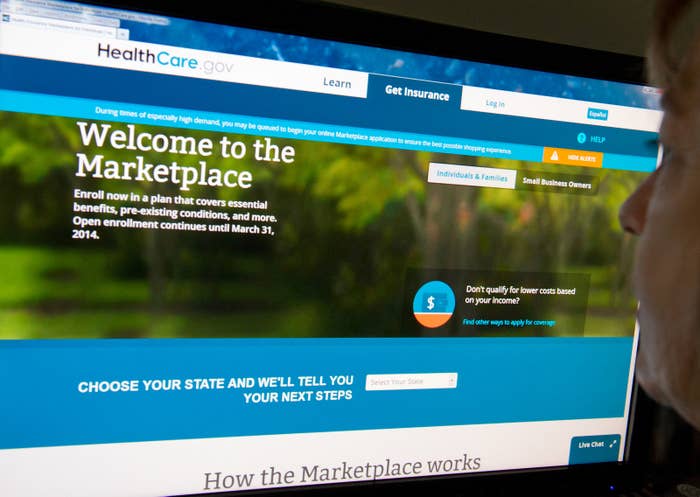
The Trump administration has drastically slashed advertising for Obamacare’s open enrollment period, which begins today, arguing that when it comes to health insurance, advertising doesn’t work. But an in-the-works study shows that this assumption could be disastrously wrong.
The Obama administration spent $100 million last year to advertise the annual window to buy insurance on the individual markets. The idea is that sicker people who use more health services know to buy insurance, but healthy people — the ones who bring down costs for everyone — have to be prodded and reminded.
But President Donald Trump has reduced advertising for the 2017 enrollment period (Nov 1. to December 15) by 90% to $10 million.
“Judging effectiveness by the amount of money spent and not the results achieved is irresponsible and unhelpful to the American people. Under the Trump administration, we’re committed to more responsible, effective government,” Health and Human Services press secretary Caitlin Oakley said in late August.
Because Obamacare is so new, research on how advertising affects the markets is hard to come by. For a direct comparison you would need to look at an area that spent heavily on Obamacare outreach one year, then turned around and spent almost nothing.
It just so happens that that’s exactly what occurred in Kentucky.
Kentucky was one of Obamacare’s greatest early success stories. The state’s uninsured rate dropped by more than half, from over 20% in 2013 to around 7% by 2015. But by 2016 pro-Obamacare Gov. Steve Beshear had been replaced by anti-Obamacare Gov. Matt Bevin. Bevin slashed market outreach in 2016 and TV ads were cut off altogether after the first few weeks of enrolment.
A team of researchers looked at the data and found that the drop in advertising correlated with 450,000 fewer page views per week and 20,000 fewer unique visitor per week to the health exchange website compared to the previous two years.
How does that relate to the number of people who actually apply for insurance? Their final paper has not yet been published, but the researchers say preliminary data shows that over one-third of insurance applications online may have been tied to TV advertising.
“Specific ad campaigns may not work” said Paul Shafer, a health policy research scholar at the University of North Carolina. “But in general, the idea that advertising is fruitless is a false narrative.”
The study is co-authored by Shafer, Sarah Gollust at the University of Minnesota, and Erika Franklin Fowler and Laura Baum at Wesleyan University.
California conducted its own research that came to similar conclusions. Though it has not been peer-reviewed, the state analysis showed that advertising is crucial to bring a healthy pool of people into the insurance markets.
The more healthy people sign up for insurance, the lower costs are for everyone. But if fewer healthy people sign up, premiums rise to cover the higher proportion of people who are expensive to care for. That can make prices unaffordable for those who are not eligible for federal subsidies.
California, one of the states that run their own own insurance exchanges, is spending $111 million on outreach this year — far more than the federal will government will spend in all 39 states that rely on Healthcare.gov.
“The effect of some of their policies are clearly phenomenally bad for consumers,” said Peter Lee, executive director of California’s health benefits exchange. “Marketing matters. You’ve got to sell insurance.”
Lee argues, based on the state’s study, that if the federal government spent at the same rate as California on outreach — 1.4% of premiums, or $480 million — over three years, the benefits would more than make up for the expense by bringing 2 million more people onto the markets and lowering premiums by 3%. That would be a significant bump given that 12 million people signed up on individual markets for 2017.
On the flip side, California projects the Trump outreach cuts will lead to one million fewer people signing up for insurance.
“The business science is clear,” said Lee. “To dial back and not spend on marketing is just mind-boggling.”
The Trump administration argues there has been no correlation between Obamacare enrollment and sign-up figures, and that after several years of living with the Affordable Care Act there is sufficient public knowledge of the Obamacare markets.
The administration cites the experience of 2016, when enrollment advertising doubled to $100 million, yet enrollment on Healthcare.gov went down by 500,000, from 9.7 million the year before to 9.2 million.
However, there are a few factors to note. One is that Louisiana expanded Medicaid eligibility. So while that state saw a drop of 70,000 on the individual market, much of this would be attributed to people enrolling in Medicaid instead. Another is the uncertain future of Obamacare at the end of 2016, with Trump just winning the White House and Republicans vowing to repeal the Affordable Care Act as swiftly as possible.
A third factor is that immediately after coming into office in January, Trump cut off advertising and outreach for the last 11 days of open enrollment. Sign-ups had been beating the previous year up until that point, but the usual last-minute rush of sign-ups at in the last few days of enrollment never occurred.
In the dozen or so states (plus Washington, DC) that run their own health exchanges and do their own advertising, there was no such drop-off. In total, those states saw a modest year-over-year increase in 2016.
But while 2016 was a unique year, the enrollment period starting this week promises to be much more radically different. On top of lower advertising, the administration has also cut direct outreach by 40% and shortened the enrollment period by half. Instead of running from the beginning of November until the end of January, it will run until December 15 (state-run marketplaces will still be open through January.)
Just about the only thing that hasn’t changed is that enrollment is still being promoted by Barack Obama.

